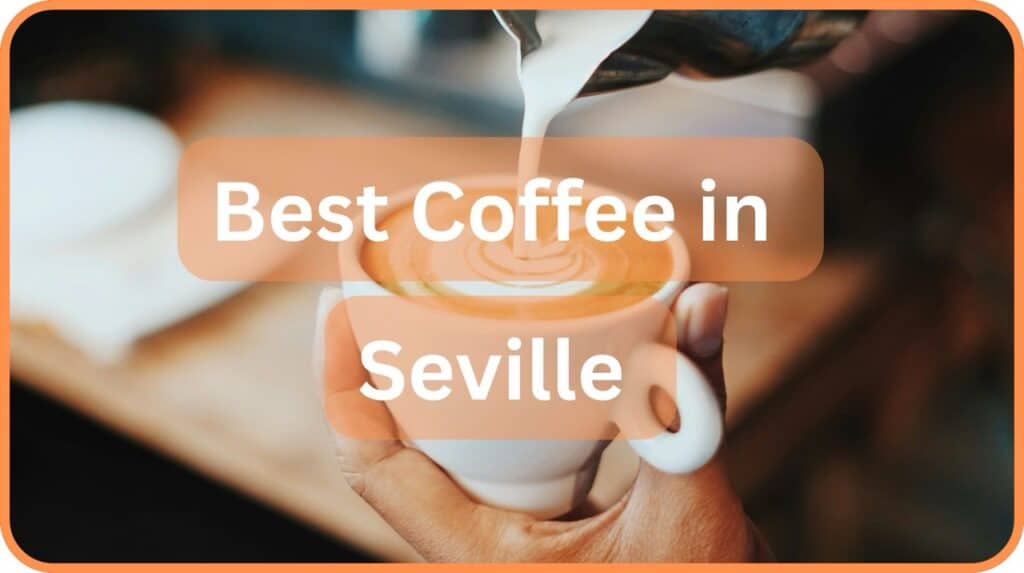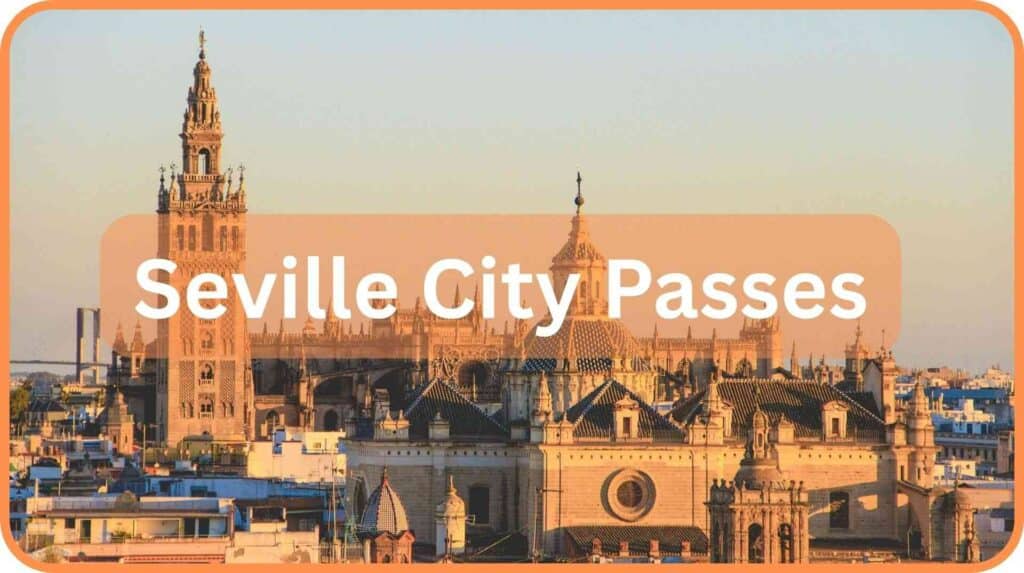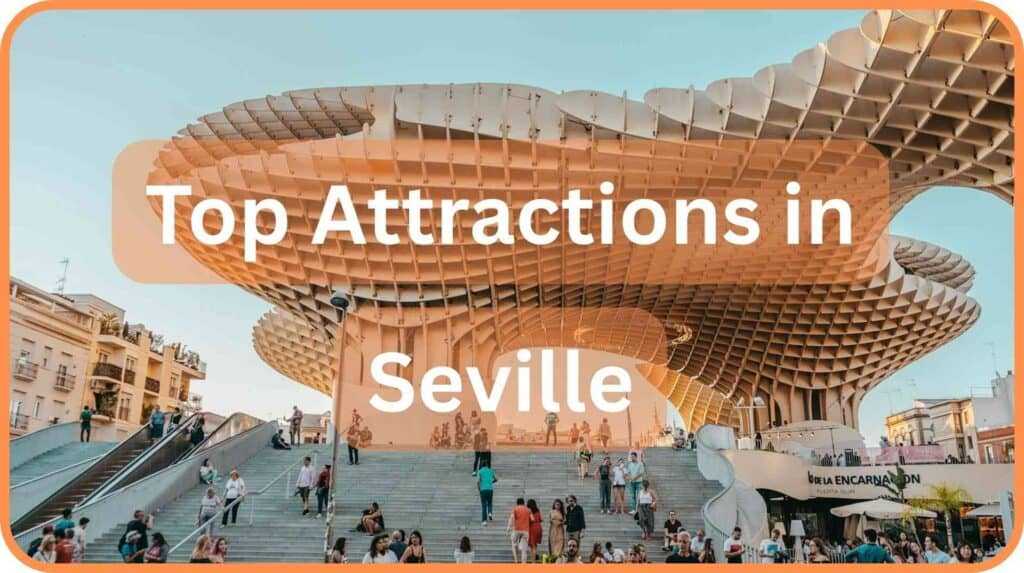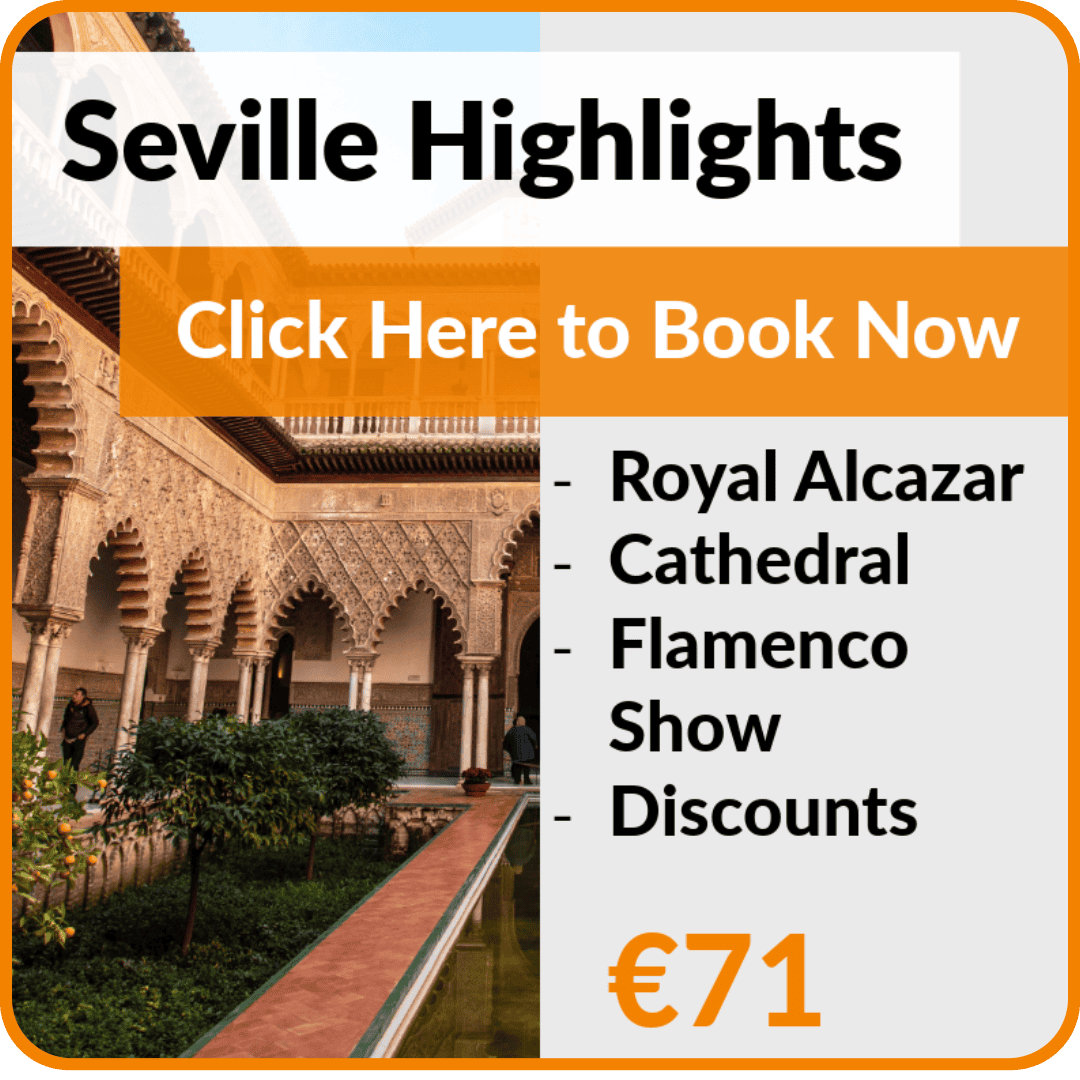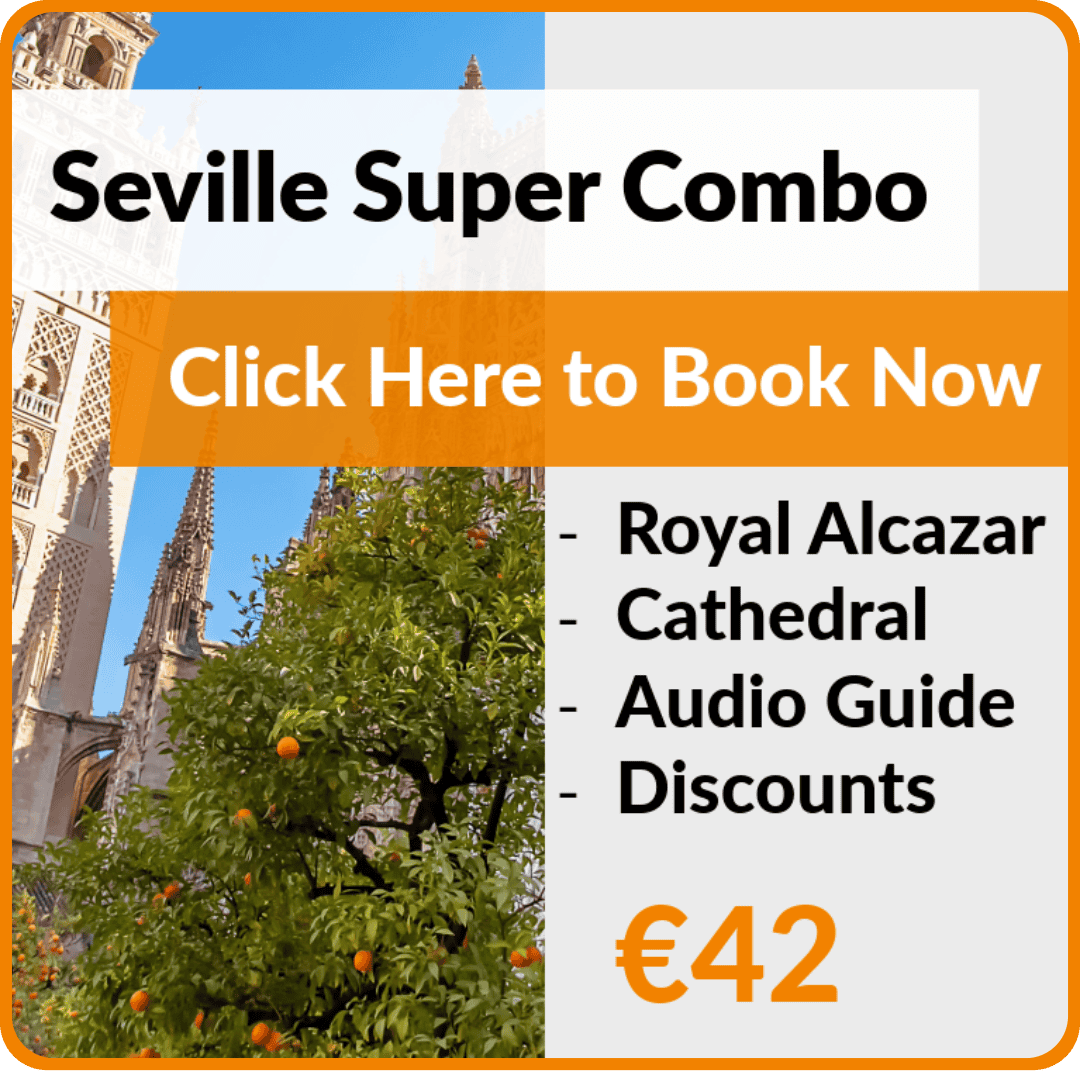Seville Itineraries
Top Attractions
- Royal Alcazar
- Seville Cathedral
- Metropol Parasol (Las Setas)
- Seville Bullring
- Plaza de Espana
- Casa de Pilatos
- Flamenco Show
- Maria Luisa Park
- Archivo de Indias
- Torre del Oro
- Seville Tiles (Azulejos)
- Bullfighting
- Football Stadium Tour
- Opera House
- Museum of Illusions
- Seville Aquarium
- Isla Mágica
- Jardines de Murillo
Disclaimer
Posts on visit-seville.com may contain affiliate links, meaning we get a small commission if you decide to make a purchase through our links, at no cost to you. Any income earned helps maintain this website and keeps it ad-free.
3 Days in Seville – The Perfect Seville Itinerary
A visit to Seville is unforgettable. With its tapas culture, Moorish architecture, flamenco, great weather, and orange trees, the city is full of charm and energy.
This 3-day Seville itinerary is perfect for first-time visitors who want to experience Seville city’s highlights without feeling rushed. Although three days might not be enough to cover absolutely everything, it’s plenty of time to see the main sights, discover local corners, and enjoy the atmosphere if you plan things properly.
We’ve detailed the itinerary day by day, with a mix of iconic places plus time to relax, try tapas (don’t miss the jamón ibérico), have a coffee or a Cruzcampo, and watch an authentic Andalusian flamenco show.
Idea: Bookmark this 3-day Seville itinerary so you can easily find it again when you’re in the city.
On desktop, press Ctrl + D (Windows) or Cmd + D (Mac).
On mobile, tap your browser’s Share icon and select “Add to Bookmarks” or “Add to Reading List”.
Day 1: Explore Historic Seville
Morning: Visit the Royal Alcazar Palace and Seville Cathedral
You’ll start the day at one of Seville’s most iconic landmarks, the Royal Alcazar, a royal palace with stunning gardens. Originally built by the Moors in the 10th century and later expanded by Spanish monarchs, the Real Alcázar is a fascinating mix of Islamic, Gothic, Renaissance and Baroque architecture. Its unique style has even made it a filming location for series like Game of Thrones and one of the most photographed places in Seville.
For us the highlight is the Patio de las Doncellas, a beautifully restored courtyard, and the Hall of Ambassadors, where Spanish monarchs once received foreign dignitaries. Don’t miss a walk through the gardens, filled with fountains, orange trees and peacocks.
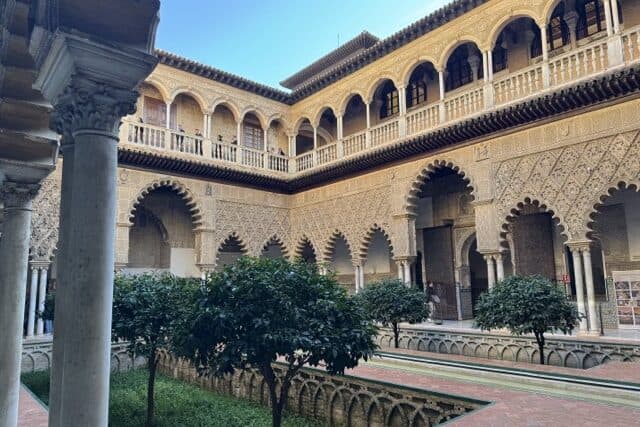
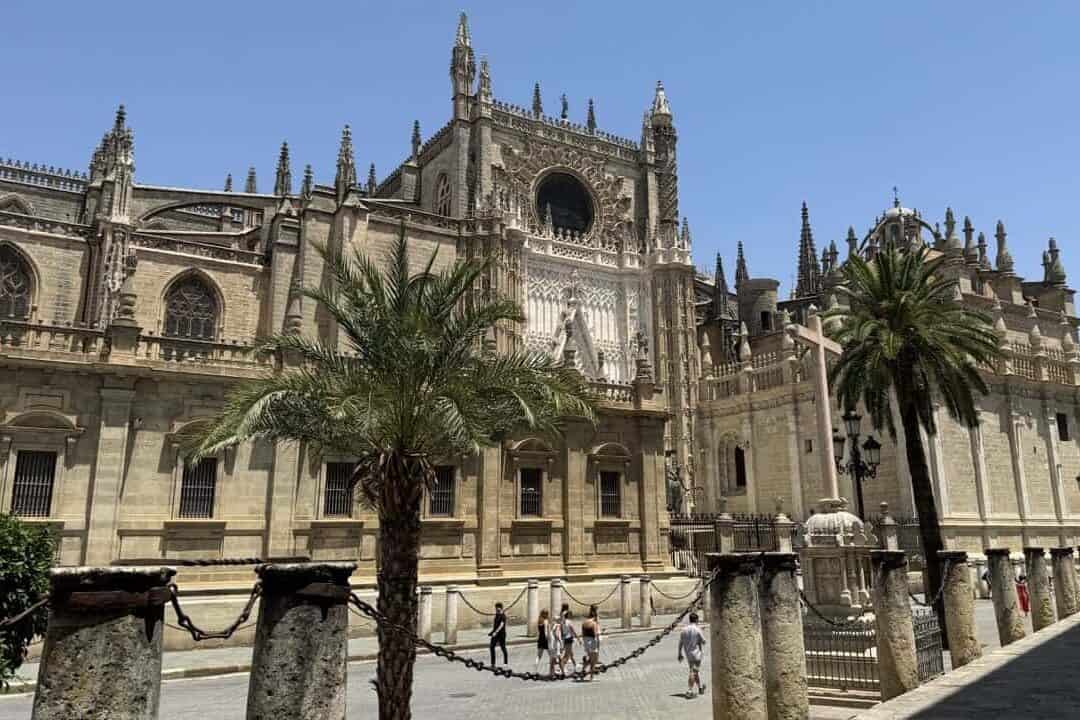
The next stop, and close by the the Alcazar is the Seville Cathedral. Simply head northeast along Avenida de la Constitución, and in about a 5-minute walk, you’ll reach the stunning Cathedral.
The Seville Cathedral was built in the early 15th century on the site of the city’s former mosque, which explains its enormous scale and the presence of the Giralda Tower, originally a minaret. It has been recognised as a UNESCO World Heritage Site since 1987.
Inside, you’ll find an impressive collection of chapels, altarpieces and colourful stained glass windows. Another key attraction is the tomb of Christopher Columbus – yes, the Christopher Columbus!
Your ticket also includes access to the Giralda Tower, one of the city’s most recognisable symbols. Inside the tower, you’ll find ramps instead of stairs, designed so horses could reach the top, making the ascent easier than most towers. From the top, you’ll enjoy some of the best panoramic views of Seville, a must for photos and a highlight of any visit.
Lunch at One of Seville’s Oldest Bars
After visiting the Alcázar and the Cathedral, we recommend stopping for lunch at one of Seville’s historic bars, all within a few minutes’ walk.
One spot we always recommend is Las Teresas, one of Seville’s oldest and most traditional bars. Open since 1870, it’s famous for its authentic Sevillian atmosphere: cured hams hanging from the ceiling, photos of bullfighters and flamenco artists on the walls, and classic Andalusian tapas like jamón ibérico, salmorejo and spinach with chickpeas.
If you’d like to try another traditional spot nearby, Casa Morales sits just behind the Cathedral and has been around since 1850. It’s known for its tiled interior and old wine vats that give the place a real sense of history.
You can also pop into Las Escobas, which claims to be one of the oldest taverns in Spain, dating back to 1386. It’s only a few minutes from the Cathedral and offers simple Andalusian dishes in a relaxed setting.
Afternoon: Explore the Historic Santa Cruz & Archivo de Indias
Next on the list is the Barrio de Santa Cruz, a charming area that it feels like stepping back in time.
Once the Jewish Quarter until the expulsion of 1492, this part of Seville is full of history, with narrow streets designed to stay cool in the summer heat, colourful houses and small flower-filled plazas. Highlights include the peaceful Plaza de Santa Cruz, the charming Callejón del Agua that runs along the old city walls, the Casa de Murillo, once home to the famous painter, and the Jardines de Murillo, a tranquil public garden that borders the old quarter.
Today, the area is also one of the most picturesque parts of the city.
There are plenty of boutique shops in the Santa Cruz area. You can find unique souvenirs, ceramics, jewellery and other traditional crafts.
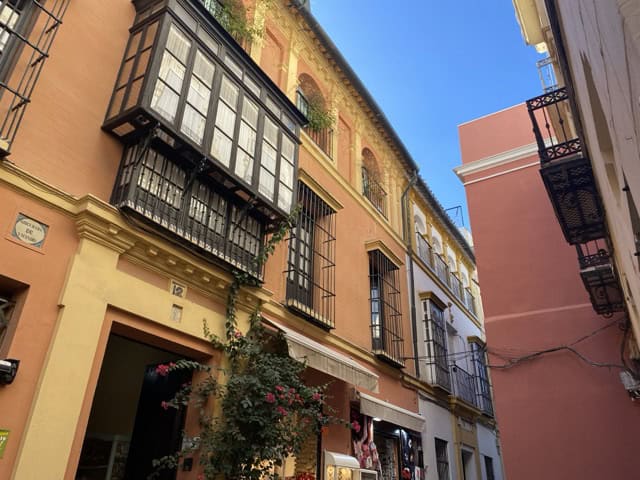
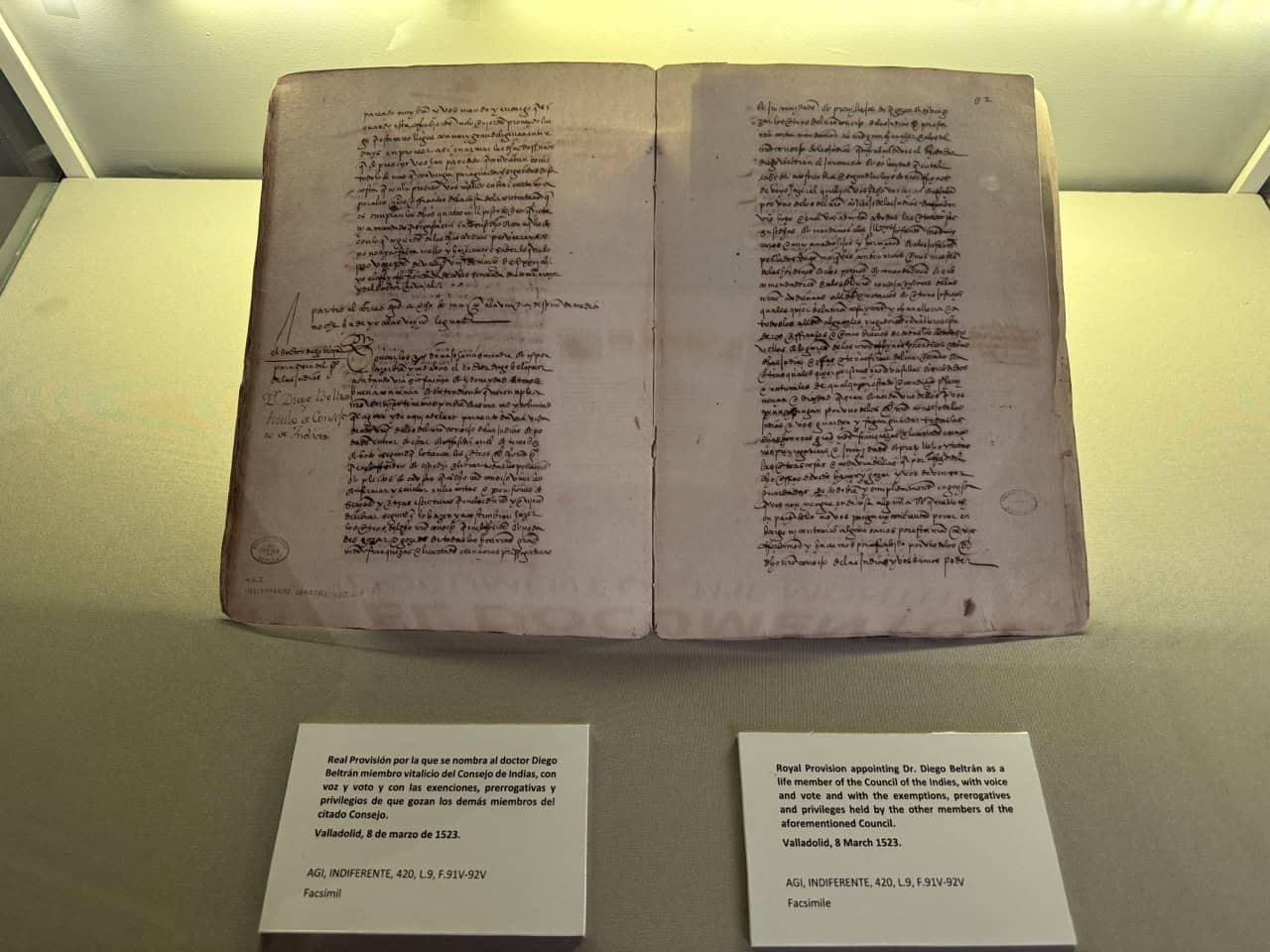
For the rest of the afternoon, we have another UNESCO World Heritage Site, the Archivo de Indias.
This historic building is all about preserving and showcasing the history of Spain’s overseas empire, and it’s full of old maps, letters, and other ancient records. It’s a fascinating place to step inside if you want to see original documents that shaped Spain’s colonial past.
The archive holds significant documents related to famous figures such as Christopher Columbus, Hernán Cortés and Francisco Pizarro, offering a unique perspective on the Age of Exploration.
Evening: Sunset at Metropol Parasol (Las Setas)
We have saved Las Setas de Sevilla, also known as the Metropol Parasol, for the evening as it’s when this landmark truly shines. Covering more than 1,500 m², it’s the largest wooden structures in the world, and you really appreciate its scale when you’re standing beneath it.
Its distinctive, mushroom-like shape has made it a favourite spot for both locals and tourists. You can walk along the elevated walkways for panoramic views over Seville’s rooftops and streets.
At sunset, the changing light creates a beautiful atmosphere, perfect for photos. After dark, the structure lights up with a colourful LED display that moves across the wooden panels, making it extra special. There’s also an interactive virtual reality experience on site, where you can see how Seville has evolved through history.
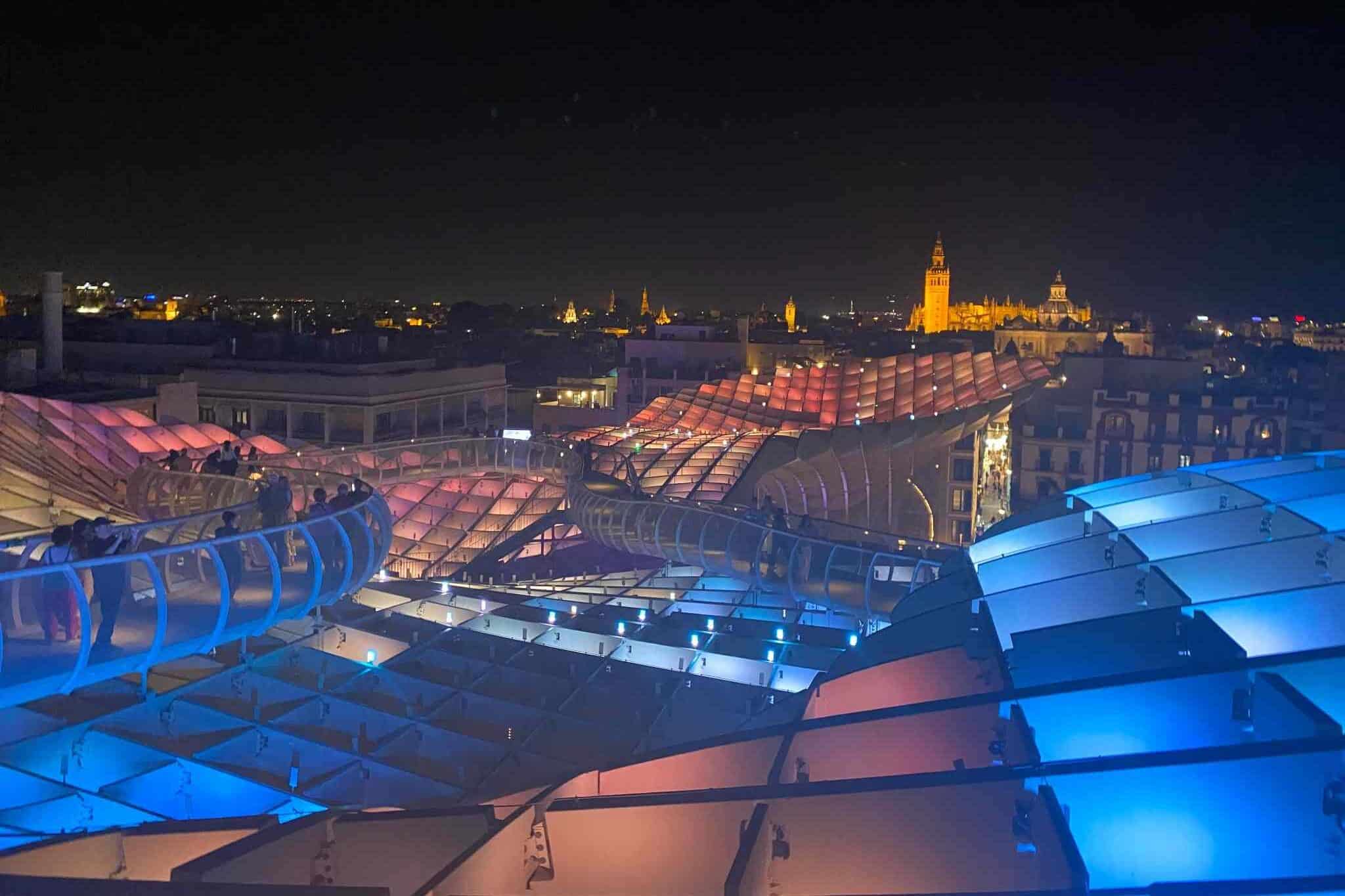
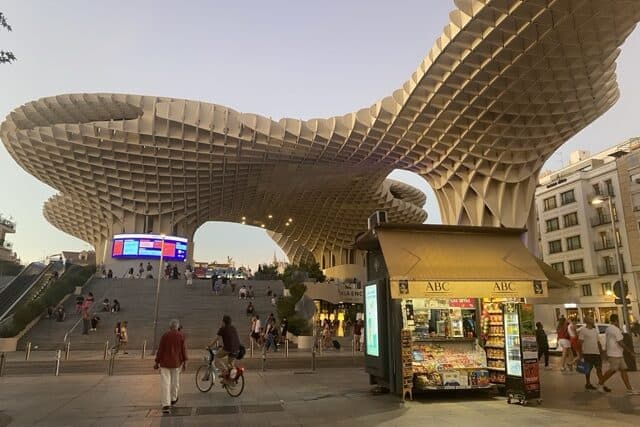
Dinner: Tapas on Calle Mateos Gagos or a Tapas Crawl Tour
After a full day of sightseeing, there’s no better way to end the evening than with tapas. One of our favourite areas to do this is Calle Mateos Gago, a lively street that connects the Cathedral with the Santa Cruz area.
This street has become one of Seville’s most popular spots for dinner for both locals and visitors because it’s central, full of atmosphere, and offers great views of the Giralda when it’s lit up after dark. If you sit outside, you can enjoy your meal with the cathedral tower glowing in the background. Most of the waiters here speak English, which makes it easy to order, but the bars still feel authentic rather than touristy.
There are plenty of options in this street, but some of our favourites spots are La Fresquita or Taberna Álvaro Peregil.
If you’d rather explore Seville’s tapas culture with some guidance, and try different places in the same night, we recommend joining a Seville Tapas Crawl. It’s a relaxed guided walk visiting a few traditional bars and bodegas that many visitors wouldn’t find on their own. Along the way, you’ll learn about the origins of tapas, taste a variety of local dishes and experience how Sevillanos enjoy their evenings out.
Day 1 Summary & Tickets |
|
Morning: Royal Alcazar & Seville Cathedral |
|
Royal Alcázar |
A UNESCO-listed royal palace blending Moorish and Christian design, famous for its intricate tilework and beautiful gardens. Tickets start from €20. Tip: The Alcázar gets very busy later in the day and entry may be restricted. It’s best to book in advance and arrive early (around 10 AM) to enjoy the palace and gardens before the crowds. |
Seville Cathedral |
The largest Gothic cathedral in the world, housing Christopher Columbus’s tomb and the iconic Giralda tower. Entry starts from €18. |
|
Tip – Save more with the Seville Super Combo |
|
Afternoon: Santa Cruz Neighbourhood & Archivo de Indias |
|
Santa Cruz |
Seville’s former Jewish quarter, a maze of narrow lanes filled with orange trees, tapas bars and courtyards. Guided walking tour available from €24. |
Archivo de Indias |
A UNESCO World Heritage archive preserving Spain’s colonial-era documents. Entry is free (closed on Mondays). |
Evening: Metropol Parasol (Las Setas) |
|
Las Setas de Sevilla |
The largest wooden structure in the world, offering panoramic views of Seville from its rooftop walkway. It’s especially beautiful at sunset. Tickets start at €16. Tip: The Metropol Parasol is one of Seville’s most popular modern attractions and gets especially busy at sunset. Tickets are sold in timed slots and the only way to guarantee entry at your preferred slot is to book online in advance. |
Day 2: Seville’s Art, Heritage and Traditions
Morning: Churros, Casa De Pilatos and your choice of Seville Bullring or Fine Arts Museum
Start your day the Sevillian way with churros con chocolate for breakfast. The most famous place for churros in Seville is Bar El Comercio, a historic café dating back to 1904, loved for its perfectly crispy churros served with thick, rich chocolate. It’s become very popular in recent years, so if it’s too crowded, Churrería San Pablo is another excellent option, a little quieter but just as authentic.
Once you’re fuelled up, make your way to Casa de Pilatos, a 16th-century palace that mixes Mudéjar and Renaissance styles. It’s one of the city’s most interesting buildings, with tiled walls, marble arches, and peaceful courtyards that show how cultures blended in Andalusia.
Take your time wandering through the main patio, the rooms that open around it and the gardens. One of the highlights is the collection of ancient Roman sculptures displayed throughout the palace, which inspired its name, the “House of Pilate”.
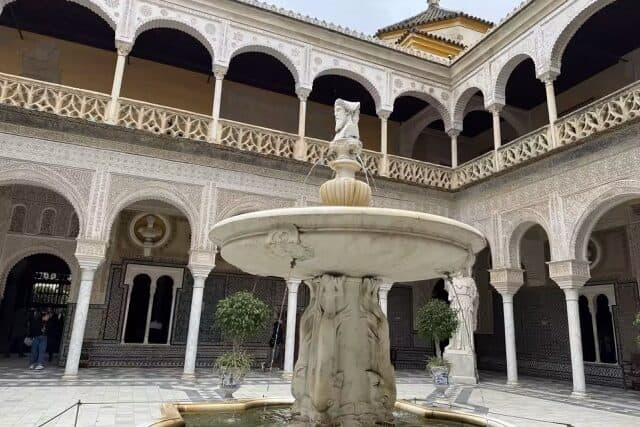
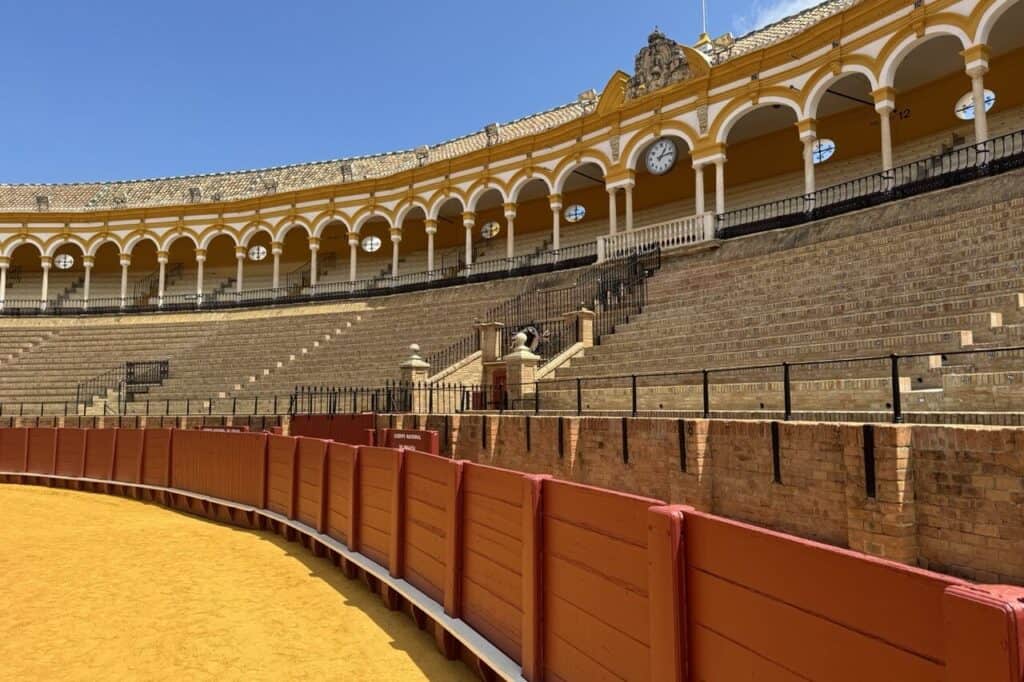
From Casa de Pilatos, it’s an easy fifteen-minute walk to the Maestranza Bullring, another landmark closely tied to Seville’s story. The arena dates back to the 1700s and is known for its white walls and golden arches.
Inside, you can walk around the stands and visit the small museum that explains the tradition of bullfighting and its role in local culture. Even if you’re not drawn to the sport, we recommend visiting for the architecture and the glimpse it offers into local culture.
If you’d prefer to skip the bullring, another great option is the Museum of Fine Arts, considered the second most important art gallery in Spain after the Prado in Madrid. Housed in a former convent, it displays an impressive collection of works by Murillo, Zurbarán, and other masters of the Sevillian school.
Lunch at Mercado Lonja del Barranco
After visiting the bullring, we recommend stopping for lunch at Mercado Lonja del Barranco, just a five-minute walk away along the river.
This modern market is one of Seville’s best spots for casual dining, with plenty of food stalls serving both local and international dishes. You’ll find everything from classic tapas and fresh seafood to Iberian ham, cheeses, paella, sushi and small gourmet bites.
The setup is simple, you can order whatever you fancy at the different stands, then take your food to any of the shared tables inside or outside on the terrace. It’s a great place to pick a few plates to share and enjoy a relaxed lunch with views of the Guadalquivir River.
Afternoon: Plaza de Espana and Maria Luisa Park
You’ll spend the afternoon exploring two of Seville’s most beautiful outdoor spaces, Plaza de España and María Luisa Park. They sit next to each other and together make one of the city’s most scenic areas to walk, relax and take photos.
Start at Plaza de España, a large semi-circular square built for the Ibero-American Exposition of 1929. Its curved building, tiled bridges, and central canal make it one of Seville’s most iconic landmarks. Along the walls, you’ll find colourful ceramic alcoves representing the provinces of Spain. You can also see the plaza from a different angle and rent a traditional wooden rowboat for €6.
Once you’ve explored the plaza, continue into María Luisa Park, which is right next to it. Spend the rest of the afternoon enjoying its tree-lined paths, ponds and fountains, where you’ll often see ducks, swans, parrots, peacocks, and fish. You can stroll through at your own pace or rent one of the four-wheel bikes (around €15) to see more of the park.
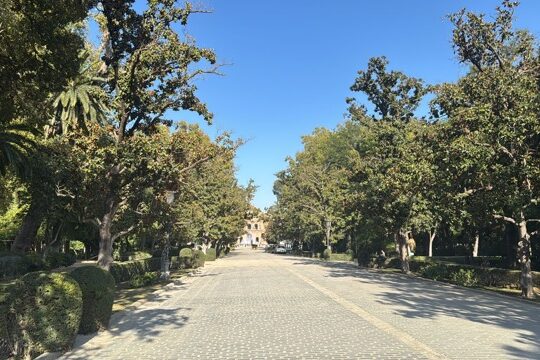
Evening: Flamenco Show with Dinner
To end your second day, immerse yourself in one of the city’s most powerful traditions – a live flamenco show in Seville.
We recommend the Flamenco Show with Dinner at La Cantaora, a small and traditional venue that keeps things simple and authentic. The atmosphere is intimate, the performances are full of emotion, and the focus is entirely on the music and the dance.
Dinner is included as part of the evening, with two tapas menus to choose from. The food is homely and full of flavour.
It’s a genuine experience and one that will likely be among the moments you remember most from your trip.
Day 2 Summary & Tickets |
|
Morning: Casa de Pilatos & Seville Bullring or Museum of Fine Arts |
|
Casa de Pilatos |
A 16th-century palace blending Renaissance, Gothic and Mudéjar styles, often described as one of Seville’s hidden gems. Entry tickets start from €12. Tip: If you’ve booked your tickets online, ignore the queue outside – just head straight to the main entrance and walk in. |
Seville Bullring (Plaza de Toros) |
One of Spain’s oldest and most impressive bullrings, dating back to the 18th century and home to a small museum about Seville’s bullfighting heritage. Guided tour with skip-the-line entry starts from €25. |
Museum of Fine Arts (Museo de Bellas Artes) |
Spain’s second most important art gallery after the Prado, featuring works by Murillo, Zurbarán and other Sevillian masters. General entry is €1.50 per person (free for EU citizens) and tickets can be purchased at the door. Guided tours available from €15. |
Afternoon: Plaza de España & María Luisa Park |
|
Plaza de España |
A grand square built for the 1929 Ibero-American Exposition, famous for its colourful ceramic alcoves and canal. Free entry, with rowboat rentals available for around €6. |
María Luisa Park |
Seville’s largest green space, filled with fountains, shady walkways and birdlife. Free to explore, with four-wheel bikes available for around €15 per hour. |
Evening: Flamenco Show with Dinner |
|
La Cantaora Flamenco Show |
An intimate flamenco performance paired with a dinner of Andalusian tapas. Tickets from €80. |
Day 3: Seville’s Riverside Charm
Morning: Torre del Oro and Guadalquivir River Cruise
Start your final day in Seville at the the Torre del Oro, or “Gold Tower” in English, one of the city’s most recognisable landmarks on the banks of the Guadalquivir River. Built in the 13th century, it once protected the port and controlled access to the river.
Inside, you can visit the small Naval Museum, which tells the story of Seville’s maritime past through ship models, maps, and artefacts from the Age of Discovery. Don’t miss the terrace at the top – the views over the river and the city are well worth the climb, especially in the morning light.
When you’re finished, take a short walk along the river and hop on a boat cruise along the Guadalquivir. It’s a relaxing way to see the city from a different angle, passing by landmarks like the Bullring, Torre del Oro and Triana Bridge. The one-hour trip includes a short commentary about Seville’s history and life along the river, and there’s a small bar on board for drinks and snacks. It offers stunning views and picture opportunities that you won’t be able to get on land.
If you are visiting in summer, we recommend going mid-morning when it’s not too hot – it’s calm, scenic, and a lovely way to enjoy Seville’s riverside charm.
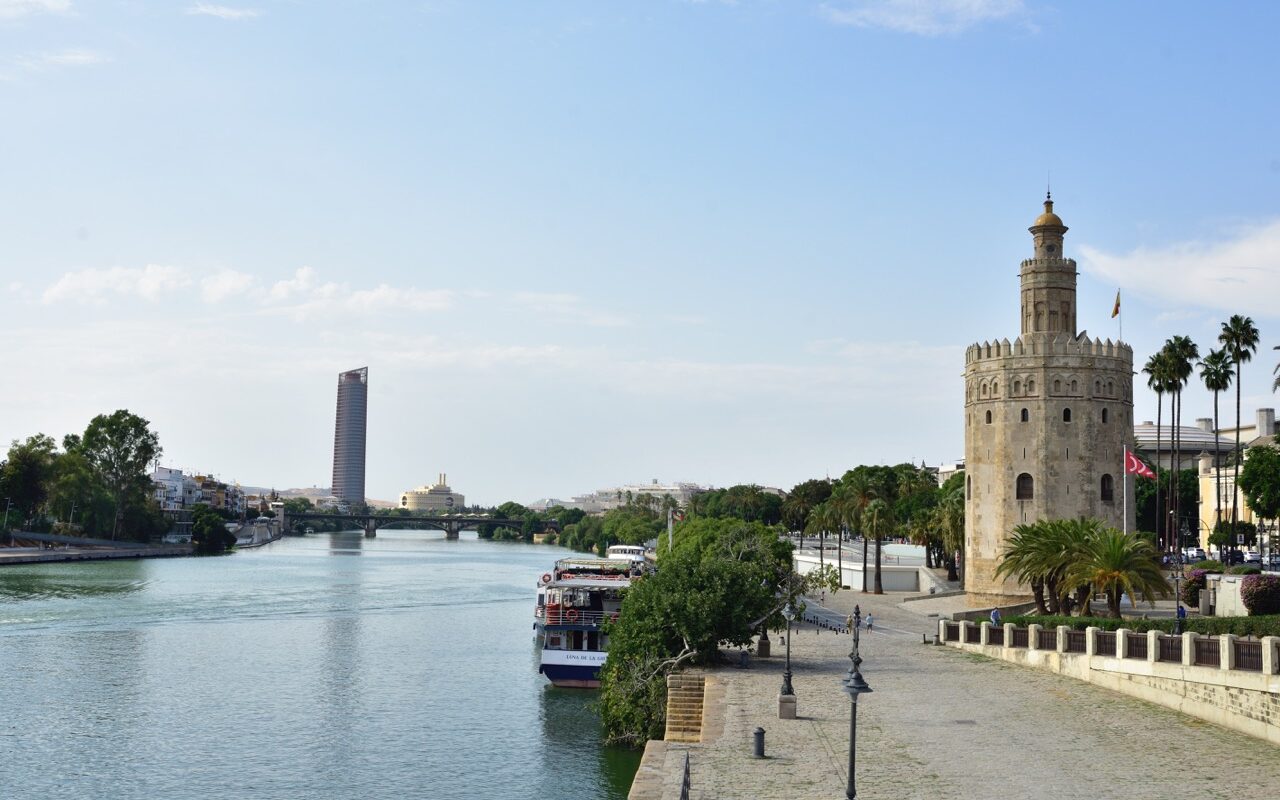
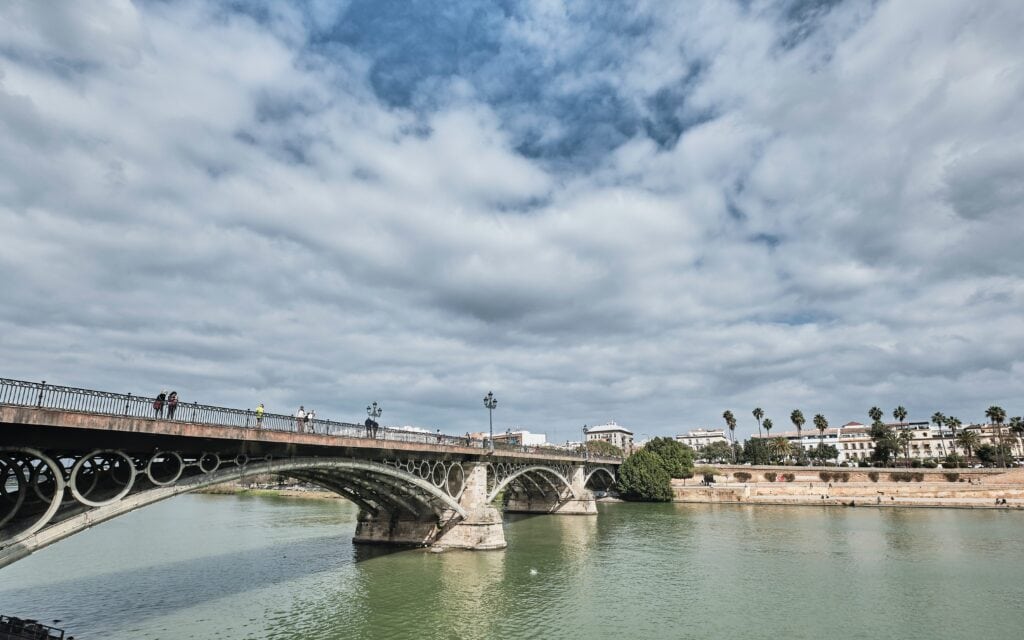
Lunch in Calle Betis
After your river cruise, cross the Triana Bridge and head to Calle Betis, one of Seville’s most picturesque streets for lunch. With its colourful buildings and riverfront terraces, it’s the perfect place to sit down for lunch and watch the city from the other side.
We recommend La Casa de María, known for its rice dishes (paellas and arroces) and a menu that highlights seasonal ingredients, or La Salina, a riverside favourite for fresh seafood and coastal Andalusian flavours.
If you’d prefer something a little more tucked away, walk a few minutes into the heart of Triana to La Antigua Abacería, a small, traditional tavern full of character and a personal favourite of ours. It’s the kind of place many visitors miss – shelves lined with wine bottles, handwritten menus and delicious tapas.
Afternoon: Triana Neighbourhood
After lunch, spend the afternoon exploring Triana, one of Seville’s most traditional and lively neighbourhoods. It’s the perfect place to slow down, wander through its narrow streets, stop for a coffee, and enjoy the local rhythm of daily life.
Before you start exploring, we recommend stopping at the Triana Market (Mercado de Triana), located right by the bridge. Inside, you’ll find stalls selling fresh produce, local delicacies,and small bars where you can grab a snack or try regional products like olives, cheeses or jamón.
Triana has a long history of ceramic and tile making, and it’s still the heart of Seville’s azulejos tradition. You’ll find small workshops and stores selling hand-painted tiles, pottery and other local crafts.
We would recommend walking along Calle San Jorge and Calle Alfarería, where many of the studios are based, or visiting the Centro Cerámica Triana, a lovely museum dedicated to the district’s ceramic heritage.
If you have time, you can also see the Castillo de San Jorge, built on the remains of a medieval fortress, or stop by the Capilla de los Marineros, a church that plays an important role in Seville’s Semana Santa celebrations.
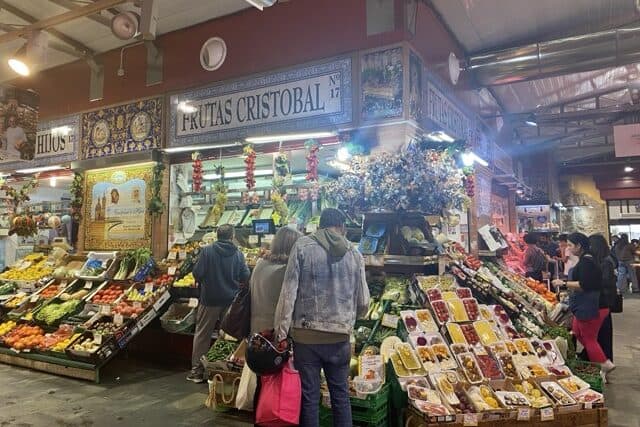
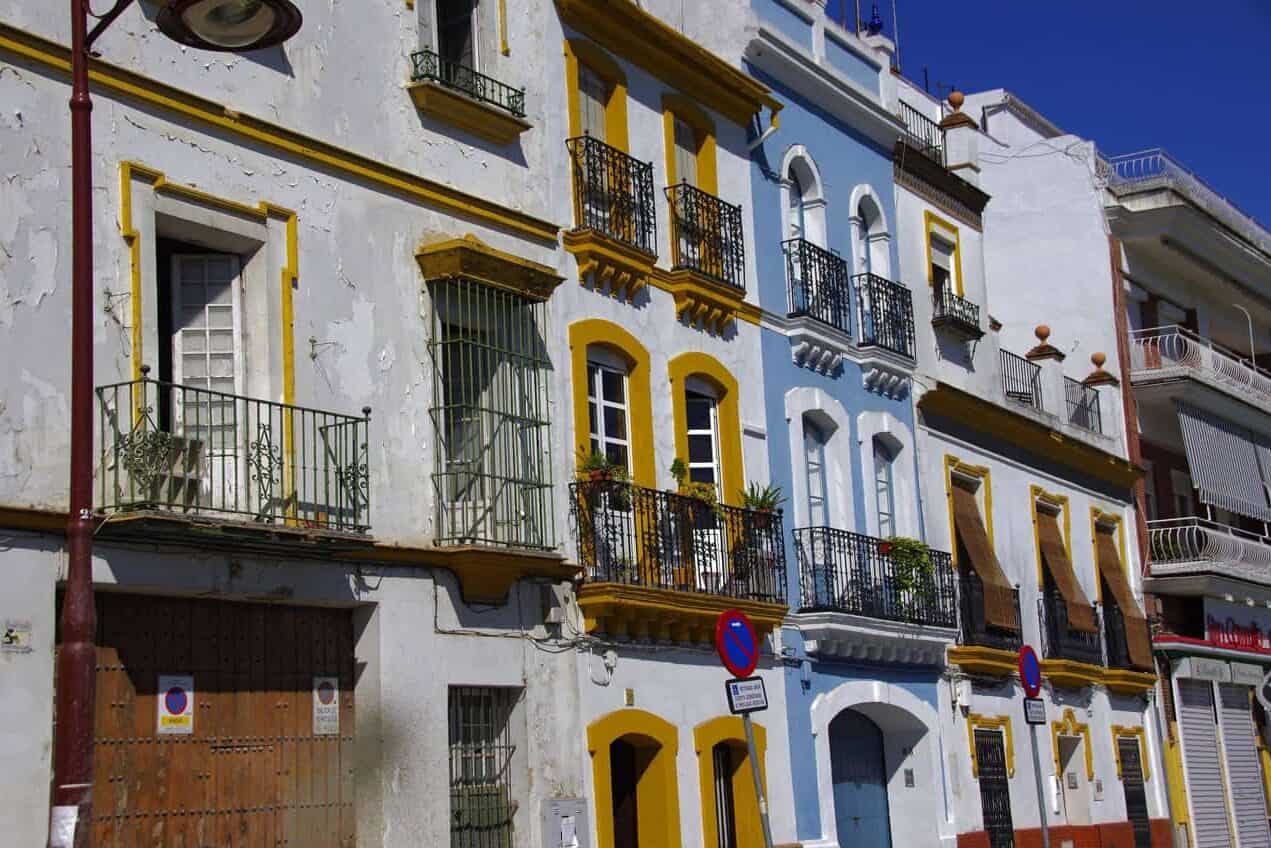
Dinner at El Rinconcillo
For your last night in Seville, we recommend ending on a true classic, El Rinconcillo, one of the oldest and most iconic tapas bars in the city. Open since 1670, it’s said to be the birthplace of the tapas tradition, and walking inside feels like stepping into a piece of Seville’s history.
The atmosphere is lively and full of character, with wooden counters, tiled walls, and waiters marking your bill in chalk. This is the place to try authentic Andalusian tapas and to pair them with a glass of local sherry or wine and enjoy the energy of a place that’s been serving locals for centuries.
It’s one of the best tapas bar in Seville and the perfect way to wrap up your trip.
Day 3 Summary & Tickets |
|
Morning: Torre del Oro & Guadalquivir River Cruise |
|
Torre del Oro |
A 13th-century watchtower that once protected Seville’s river port. General admission is €3 for adults, with tickets available at the entrance only (no advance booking). |
Guadalquivir River Cruise |
Enjoy a 1-hour sightseeing eco-cruise along the Guadalquivir River for a different view of Seville’s skyline. Tickets start from €17 per person. |
Afternoon: Triana Neighbourhood |
|
Triana |
Explore the traditional Triana district, famous for its ceramic workshops, tapas bars and colourful streets overlooking the river. |
Map for 3-Day Seville Itinerary
Use this interactive map to follow our 3-day route. It includes all the main landmarks, neighbourhoods and food spots from the guide, most of which are within easy walking distance in the city centre.
Zoom in and tap any pin for details. Click the square “open” icon to launch it in Google Maps, where you can save the map to your account and get directions between points (with walking times and routes). On mobile, it opens in the Google Maps app so you can navigate between stops as you go.
Where to Stay in Seville
If you’re spending only 3 days in Seville, we recommend staying in the city centre (Casco Antiguo), areas like Santa Cruz, El Arenal, Alfalfa, Museo or around Encarnación–Regina. You’ll be within easy walking distance of the Alcázar, Cathedral and Plaza de España, which makes it ideal for a first visit.
Keep in mind that central Seville can be more expensive and busier but the convenience and atmosphere are worth it. You’ll be able to walk almost everywhere and won’t need to rely much on public transport.
If you prefer somewhere a little quieter or more affordable, consider staying in Triana, Los Remedios or Nervión. These areas are still close to the centre, about a 30 minute walk or a short metro or bus ride.
Accommodation in central Seville tends to book up quickly, especially in spring and early summer when the city is at its liveliest. To get the best selection and rates, it’s highly recommended to book your hotel in Seville early, especially if you want to stay near the main attractions.
How to Get Around Seville
One of the best things about Seville is how walkable it is. Most of the city’s main attractions are close together, especially around the historic centre. If you’re following our 3-day Seville itinerary, you’ll find that you can walk almost everywhere without needing much public transport in Seville. We’ve organised the days with proximity in mind so you spend more time exploring and less time getting around.
That said, it’s good to know your options. The Seville Tram connects key spots like San Bernardo Train Station and Plaza Nueva, making it handy if you are doing any day trips from Seville. If you want a scenic and easy way to get between the main sights, the Seville Hop On Hop Off Bus is another great option, it stops at the main landmarks and includes an audio guide.
For longer distances, Seville also has a metro and a reliable bus network, though you probably won’t need them much if you’re staying in or near the city centre. And of course, taxis in Seville and rideshare apps like Uber or Cabify are always available for late-night returns or when your feet need a break.
Top Tips for Visiting Seville in 3 Days
- Start your days early – Attractions like the Royal Alcázar and Seville Cathedral get busy quickly, especially in spring. Arriving early not only helps you explore them without the crowds but also lets you enjoy the city before the heat picks up.
- Plan for the heat – Seville is one of Europe’s warmest cities, particularly from May to September. Bring a refillable water bottle, wear light clothes, and take breaks indoors or in shaded areas during midday.
- Book tickets in advance – Major sights like the Alcázar, Cathedral and flamenco shows often sell out well in advance, sometimes weeks ahead. The only way to guarantee entry for your dates is to book tickets online as soon as you know you’ll be visiting Seville.
- Stay central if you can – Neighbourhoods like Santa Cruz, El Arenal and Casco Antiguo are perfect for sightseeing on foot. Most attractions are within easy walking distance, so you won’t need much public transport.
- Wear comfortable shoes – Seville’s cobbled streets and tiled courtyards are beautiful but can be tough after a full day of exploring.
- Carry some cash – Most places take cards, but cash is preferred for tipping in Seville. In Seville, tips left by card usually go to the owner, not the staff, so it’s always nicer to leave a few euros directly.
- Tipping is optional but appreciated – Locals usually round up the bill or leave around 5–10% in restaurants if service was good.
- No tourist tax – Unlike many European cities, Seville currently doesn’t charge a tourist tax, so what you see on your accommodation bill is what you pay.
Frequently Asked Questions
How many days do you need in Seville?
You can see Seville’s main highlights in 2 or 3 days, but spending 3 full days allows you to explore at a more relaxed pace and truly enjoy the city’s atmosphere. With three days, you’ll have time to visit top landmarks like the Royal Alcázar, Seville Cathedral and Plaza de España, attend a traditional flamenco show, and wander through Santa Cruz, Triana, and the city’s beautiful parks.
What’s the best time of year to visit Seville?
The best time to visit Seville is in spring (March to May) or autumn (September to November). The weather is warm but comfortable, and the city is especially lively during Semana Santa (Holy Week) and the Feria de Abril. We recommend avoiding the summer months as it can be very hot, with temperatures over 40°C.
Can you walk everywhere in Seville?
Yes, you can walk everywhere in Seville as most of the main attractions are close together in the historic centre (Casco Antiguo), and the streets are mostly flat.
More on Visit-Seville

